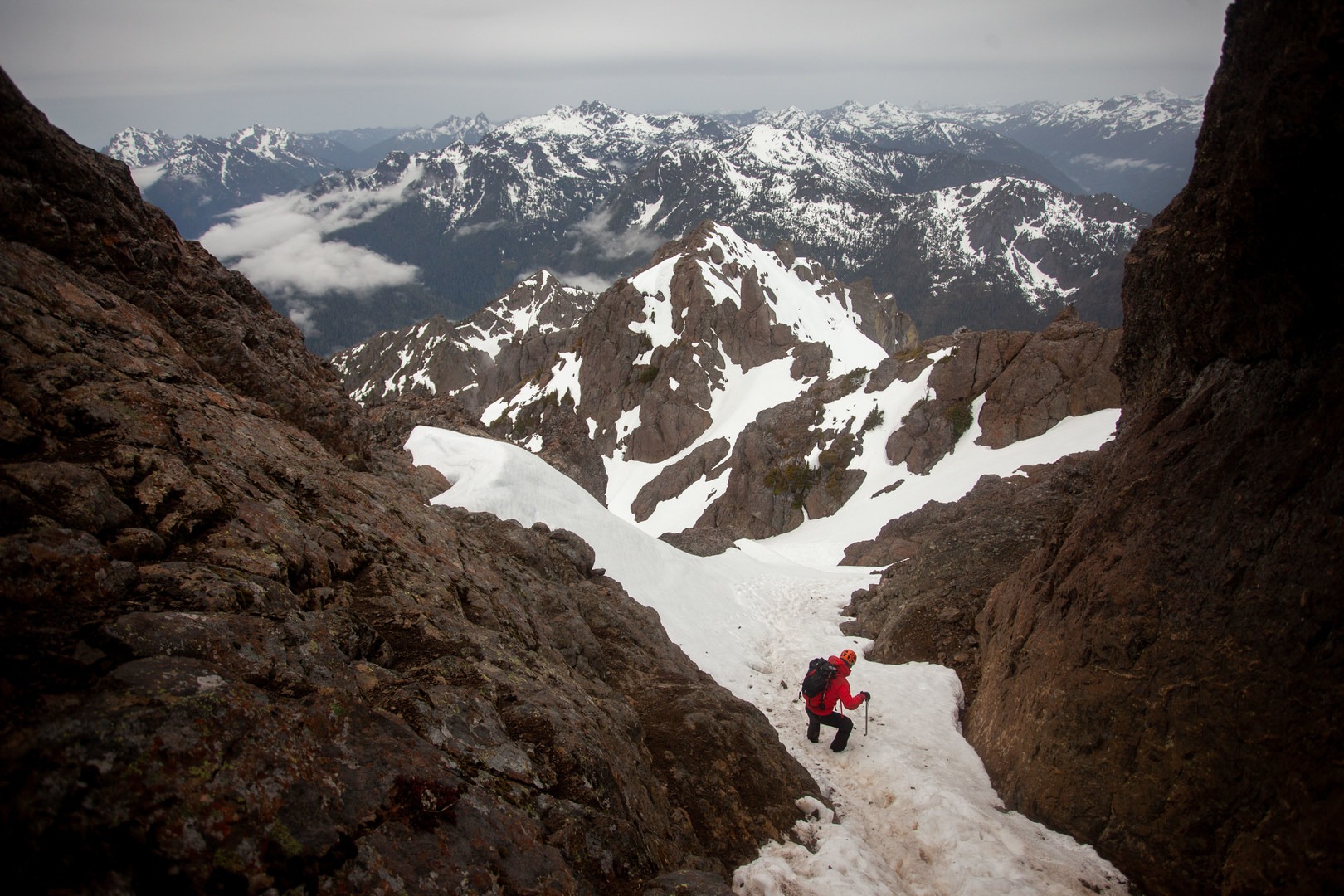You are here
The Brothers, located in Washington's Olympic Mountains, are probably the most recognizable non-volcanic peak visible from Seattle. If you can see the Olympics , you'll probably be able to see the Brother's two-pronged summit.
This report is about climbing South Brother, which requires you to be comfortable using an ice axe and crampons, as well as moving on steep terrain with some exposed rock scrambling. This report is not about the Brothers Traverse or about North Brother, both of which are far more technical and involved trips, requiring the use of a rope + rock and snow protection.
Seasonality/Timing
South Brother can be climbed year-round, but the trip changes dramatically through the different seasons. Standard climbing season is early spring to early summer. Too early in the season, and the snow is often too unstable (read avalanche danger) to climb the snow gullies of the standard route, and there's no way around. Too late in the season (late June or later), and the snow gullies become steep loose rock funnels - the Olympics are known for their horribly loose rock. It is highly recommended to avoid these gullies when they've lost their snow, as you cannot control debris being kicked down from above.
Number of Days
Before you get on this route, you'll need to decide if you want to do it in the standard 2 days (involving camping at the Climber's Camp at 3100 feet on the East Fork of Lena Creek) or the burlier car-to-car single-day push. Keep in mind, with all the downed logs, burned zones, and loose rock, you'll need to be fast and efficient to get this done in a day.
The Climb
You'll start at the Lena Lake trailhead, where you'll likely see a lot of day hikers gearing up for the relatively mellow hike to Lena Lake. You'll join them, wandering up the low-angle switchbacks, before contouring around the west side of Lena Lake. You'll cross over Lena Creek, then head up the rougher climber's trail. This trail has a lot of downed trees (as of spring 2020), so try to follow the flagging/bootpack as well as you can. If you lose the trail, pull out your GPS and continue heading up valley, you'll likely see some flagging soon.
This section up to the climber's camp brings you through extraordinary old-growth forest, named the "Valley of Silent Men" for the enormous trees that surround you. Oddly, the East Fork of Lena Creek disappears underground at points, making the silence complete. At 3,100 feet, you'll find the climber's camp. There are a ton of campsites, so if you don't find one immediately, just keep heading west up the climber's trail and you'll find something soon. Make camp and get ready for an early morning.
On day two, you'll wake up early and get on the narrow use-trail, climbing steeply through the forest, before coming out into a valley, with an obvious burn-zone above you (3700'). There's no good path through this burn-zone - as of spring 2020 there were two semi-cairned bootpacks, both of which involved a lot of scrambling over downed trees. Finally, you'll emerge out of the top. If you're climbing in the spring, you'll get onto snow soon afterward. From here, you'll climb straight up the large gully above you. Depending on snowpack, you'll either go up through the "hourglass" at 5,200 feet or cut out right and follow cairns along the low angle rock to avoid it.
Above the hourglass, you'll get back into the main chute (40+ degree) and start kickstepping. This section is steep! You'll gradually exit this chute into a bowl and head right toward an obvious rock scramble (at 6,700'). This is exposed class III with bad fall potential, so if you're not comfortable scrambling unroped, you'll want a belay here. However, you'll need to be careful about your anchor, as the rock isn't very solid in this area.
Once you top out and exit the exposed scramble, you're almost there. Rock hop to the summit and drink in the huge 360-degree views, including the deeper Olympics (and Mount Olympus, which can't be seen from any roads), Seattle, and, if you're lucky, all the nearby volcanoes!
After you've enjoyed the view, head down the snow. Be careful if you're thinking about glissading - those chutes are steep and generally end in some pretty ominous rocks. Thrash back down through the burn-zone, pack camp, and descend back to the car. If it's warm enough, consider a quick dip in Lena Lake before the final switchbacks.
Logistics + Planning
Current Weather: Powered by Dark Sky
























Comments
Sign In and share them.